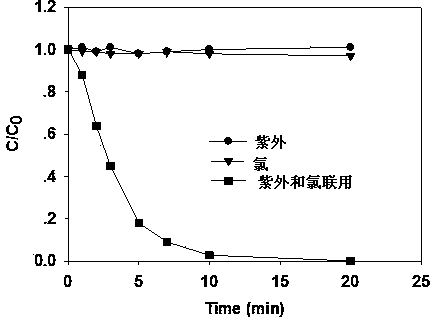Method for removing micro-pollutants in water via combination of ultraviolet light and free chlorine
A technology for pollutants and water removal, applied in the field of micro-pollutant control, can solve the problems of negative impact on human survival and health, threats to aquatic organisms' living environment, high hazard stability, etc., and achieves easy popularization and application, low cost, guarantee The effect of water safety
- Summary
- Abstract
- Description
- Claims
- Application Information
AI Technical Summary
Problems solved by technology
Method used
Image
Examples
specific Embodiment approach 1
[0026] This embodiment is based on the combination of ultraviolet light and free chlorine to remove micro-pollutants in water according to the following method: add chlorine to water containing micro-pollutants, and fully stir, and then perform light irradiation to complete the removal of micro-pollutants in water . Among them, chlorine is hypochlorous acid (sodium, potassium, calcium, magnesium) or chlorine gas. The dosage of chlorine depends on the water quality conditions and the concentration of pollutants in the water. The molar ratio of chlorine to micro-pollutants in water is 1:1~100 : 1 add.
[0027] In this embodiment, light irradiation can use sunlight, low-pressure mercury lamp, medium-pressure mercury lamp, high-pressure mercury lamp, amalgam ultraviolet lamp, and halogen lamp to meet the conditions of use, and can also use xenon lamp, black lamp, vacuum ultraviolet lamp, One of X-rays, alpha rays, or gamma rays.
[0028] In this embodiment, the chlorine dosing m...
specific Embodiment approach 2
[0030] The difference between this embodiment and the specific embodiment 1 is that the chlorine dosing method adopts the solution method, the light irradiation adopts the immersion method, and the outer wall of the ultraviolet light source needs to be protected by a nested quartz tube.
specific Embodiment approach 3
[0032] The difference between this embodiment and specific embodiment 1 is that chlorine is directly added in the form of chlorine gas, and the light irradiation adopts surface irradiation, and the ultraviolet light source does not need to be protected by nesting quartz tubes.
PUM
 Login to View More
Login to View More Abstract
Description
Claims
Application Information
 Login to View More
Login to View More - R&D
- Intellectual Property
- Life Sciences
- Materials
- Tech Scout
- Unparalleled Data Quality
- Higher Quality Content
- 60% Fewer Hallucinations
Browse by: Latest US Patents, China's latest patents, Technical Efficacy Thesaurus, Application Domain, Technology Topic, Popular Technical Reports.
© 2025 PatSnap. All rights reserved.Legal|Privacy policy|Modern Slavery Act Transparency Statement|Sitemap|About US| Contact US: help@patsnap.com

